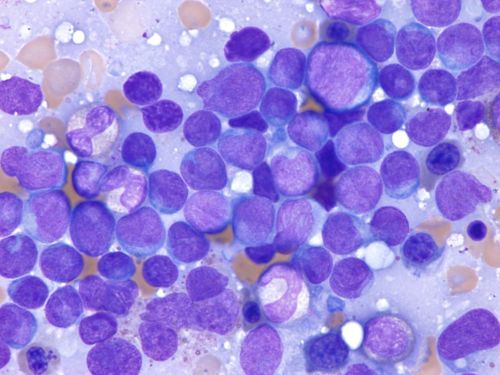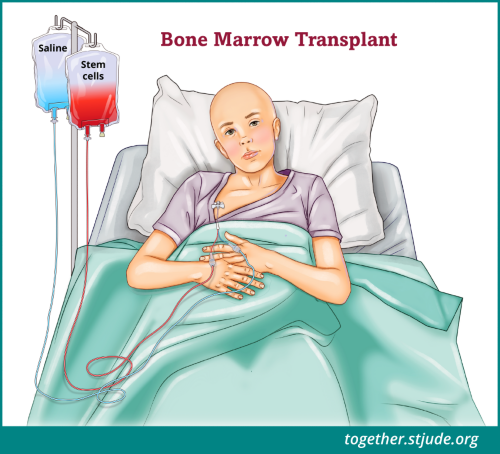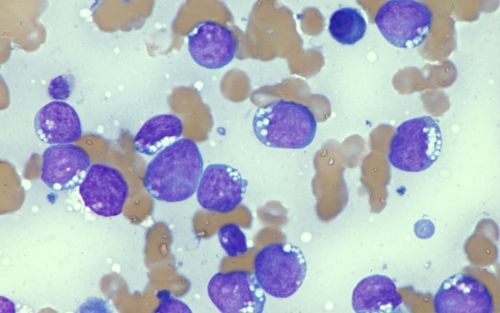What is lymphoblastic lymphoma?
Lymphoblastic lymphoma is an aggressive type of non-Hodgkin lymphoma.
Lymphoma is a cancer of the white blood cells. These cells are part of the body's immune system.
Lymphoblastic lymphoma begins in young immune cells called lymphoblasts. Normally, lymphoblasts develop into T lymphocytes or B lymphocytes , which fight infection and disease. A genetic change in these cells causes them to become cancerous. They travel to other parts of the body through the lymphatic system, or lymph system.
With the appropriate treatment, the chances of 5-year survival for children in the United States is greater than 80–90%, depending upon the cancer stage.
Symptoms of lymphoblastic lymphoma
Risk factors for lymphoblastic lymphoma
Diagnosis of lymphoblastic lymphoma
Types of lymphoblastic lymphoma
Lymphoblastic lymphoma has 2 types:
- T-lymphoblastic lymphoma (T-LL) is in a part of the body called the mediastinum, the space between the lungs. T lymphocytes grow there in an organ called the thymus. The cancer can grow quickly and spread through the lymph system. Rapid diagnosis and treatment are important. If this cancer spreads to the blood and bone marrow, it is called T-acute lymphoblastic leukemia (T-ALL).
- B-lymphoblastic lymphoma (B-LL) starts in the B lymphocytes and grows more slowly in areas such as the skin, bone, or lymph nodes. If this cancer spreads to the blood and bone marrow, it is called B-acute lymphoblastic leukemia (B-ALL).
Both T-LL and B-LL may spread to other parts of the body.
Stages of lymphoblastic lymphoma
The care team plans treatment based on the cancer stage. Some tumors grow rapidly. So, the care team must stage the lymphoma as quickly as possible.
To find out the stage of NHL, doctors may order more tests such as:
The stage will tell how much cancer is present and if it has spread to other parts of the body.
The International Pediatric Non-Hodgkin Lymphoma Staging System divides childhood lymphoblastic lymphoma into 4 stages depending on what parts of the body show disease at diagnosis. For lymphoblastic lymphoma, all stages are typically treated similarly and involve similar treatments to those used for lymphoblastic leukemia.
Treatment of lymphoblastic lymphoma
Treatment depends on the following:
- Type of lymphoma and any gene changes
- How well it may respond to treatment
- Available treatments
- Patient age and health
Treatment may include:
The doctor will review the treatment options. For some patients, the doctor may suggest a clinical trial of chemotherapy with different approaches to prevent the spread of lymphoma to the central nervous system.
Treatment for recurrent lymphoblastic lymphoma includes chemotherapy and/or high-dose chemotherapy with a hematopoietic cell transplant (also called a bone marrow transplant or stem cell transplant). Radiation may be used for some cases of relapse. Some patients may be able to take part in clinical trials to test new treatments.
Prognosis for lymphoblastic lymphoma
The prognosis depends on several factors. These include the stage of the disease and the genetic changes that caused the lymphoma.
With the proper treatment, the 5-year survival rate in the U.S. is around 90% for children with limited stage (stage 1 or 2) lymphoblastic lymphoma.
The 5-year survival rate for more advanced (stage 3 or 4) lymphoblastic lymphomas is generally higher than 80%.
Support for lymphoblastic lymphoma
Coping with a cancer diagnosis and treatment can be stressful for the patient and family. You may want to talk with a social worker, psychologist, or another mental health specialist.
Learn how to talk to your child about cancer.
After treatment, your child's doctor may use imaging tests and exams to watch for recurrence. Childhood cancer survivors should get follow-up care throughout their lives. Some treatments can cause late effects. These are health problems that happen months or years after treatment ends.
After completing treatment, it is important to:
- Have regular checkups and screenings by a primary care provider
- Maintain healthy habits, including physical activity and healthy eating
- Have a survivorship care plan to share with health providers. This plan should include:
- Guidance on health screenings
- Disease risk factors
- How to improve health
Questions to ask your care team
Find out more information





